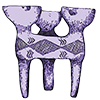Nomadic Women in the Late Ottoman Anatolia According to British Travelogues and Otto-man Archival Sources
DOI:
https://doi.org/10.33831/jws.v24i2.439Keywords:
tribe, women, nomad, Ottoman, traveloguesAbstract
It is a fact that representation of no-madic women in the Ottoman historiog-raphy is quite insufficient and left un-touched. Although there are anthropolog-ical and sociological studies on nomadic women, Ottoman historiography’s defi-ciency on this topic is due to many multi-faceted reasons. In this study, a signifi-cant and modest contribution will be made to the literature within the frame-work of some rarely found information regarding the nomadic women’s repre-sentation. Although Ottoman archival sources can provide limited data, some archival documents show important insights on the issue. Also, some data on the versality of nomadic women’s repre-sentation will be shared in the light of the writings of British male travelers’ direct observations despite their orientalist and modernist prejudices on the social life in late Ottoman Anatolia. Based on these accounts and some Ottoman archival records in the last period of the empire, the diversity and versatility of the politi-cal and social status of nomadic women in their own public sphere will be dis-cussed. Within the framework of the cri-tique and analysis of these data, this study, away from over-generalizations, aims to contribute to the other studies on the role of the nomadic women.
References
Ainsworth, W. (1839). “Notes on a Journey from Constantinople, by Heraclea, to Angora, in the Autumn of 1838”. Journal of the Royal Geographical Soci-ety of London, 9: 216- 276.
Ainsworth, W. (1840). “Notes on a Journey from Kaisariyah, by Malatiyah, to Bir or Birehjik, in May and June 1839”. Journal of the Royal Geographical Society of London, 10: 311- 340.
Ak, M. (2017). “Yörüklerde Kadın”. JASSS, 58: 307- 336.
Aksoy, E.(2009). “The Identity of Women in the Sub-Culture of Nomadic Yuruks”. Sosyal Bilimler Dergisi, 22: 23- 28.
Brant, J.and A. G. Glascott (1840). “Notes of a Journey Through a Part of Kur-distan, in the Summer of 1838”. Journal of the Royal Geographical Society of London, 10: 341- 434.
Buckingham, J.S. (1827). Travels in Mesopotamia, vol. I, London: Henry Col-burn.
Chatty, D. (2013). “Changing Sex Roles in Bedouin Society in Syria and Lebanon”. Women in the Muslim World, ed. Lois Beck and Nikki Keddie, London: Harvard University Press: 399- 415.
Demir, N. (2006). “Osman Bey (Frederick Millingen)’e Göre XIX. Yüzyılda Türk Kadınının Toplumsal Konumu”. Ankara Üniversitesi Dil ve Tarih-Coğrafya Fakültesi Dergisi, 46(1): 41-51.
Dickson, B. (1910). “Journeys in Kurdistan”. The Geographical Journal, 35(4): 357- 378.
Dominian, L. (1915). “The Peoples of Northern and Central Asiatic Turkey”. Bulletin of the American Geographical Society, 47(11): 832- 871.
Driver, G. R. (1922). “Studies in Kurdish History”. Bulletin of the School of Oriental Studies, University of London, 2(3): 491- 511.
Düğer, S. (2015). “Batılı Kadın Seyyahlar İmgeleminde Osmanlı Kadını”. KOS-BED, 29: 71-90.
Ekinci, M.R. (2022). Sebep ve Sonuçlarıyla Kırım Harbi 1853-1856, Ankara: Duvar Yayınları.
Fraser, J. B.(1840). Travels in Koordistan, Mesopotamia, vol. I, London: Richard Bentley.
Garnett, L.M.J. (1890). Women of Turkey and Their Folklore. London: David Nutt.
Garnett, L.M.J. (1911). Turkish Life in Town and Counrty. London: Knickerbocker Press.
Millingen, F. (1870), Wild Life Among the Koords, London: Hurst and Blackett Publishers.
Hasluck, F.W. (1921). “Heterodox Tribes of Asia Minor”. The Journal of the Royal Anthropological Institute of Great Britain and Ireland, 51: 310- 342.
Kutluata, Z. (2006). “Gender and War During the Late Ottoman and Early Re-publican Periods: The Case of Black Fatma(s)”. Yüksek Lisans Tezi, Sabancı Üniversitesi, Sosyal Bilimler Enstitüsü, İstanbul.
Molyneux-Seel, L. (1914). “A Journey in Dersim”. The Geographical Journal, 44(1): 49- 68.
Pierce, L. P. (2016). Harem-i Hümayun: Osmanlı İmparatorluğu’nda Hükümranlık ve Kadınlar. İstanbul: Tarih Vakfı Yurt Yayınları.
Pollington,V. (1840). “Notes on a Journey from Erz-Rum, by Mush, Diyar-Bekr, and Bireh-jik, to Aleppo, in June, 1838”. Journal of the Royal Geographical Society of London, 10: 445- 454.
Shiel, J. (1838). “Notes on a Journey from Tabríz, Through Kurdistan, via Vân, Bitlis, Se'ert and Erbíl, to Suleimaniyeh, in July and August, 1836”. Journal of the Royal Geographical Society of London, 8: 54- 101.
Stuart, R. (1876-1877). “The Ascent of Mount Ararat in 1856”. Proceedings of the Royal Geographical Society of London, 21(1): 77- 92.
Sykes, M. (1907). “Journeys in North Mesopotamia”. The Geographical Journal, 30(3): 237- 254.
Sykes, M. (1908). “The Kurdish Tribes of the Ottoman Empire”, The Journal of the Royal Anthropological Institute of Great Britain and Ireland, 38: 451- 486.
Tarduş, İ. (2022). İngiliz Seyyahların Gözüyle Ondokuzuncu Yüzyılda Kürtler. İstanbul: Avesta Yayınları.
Taylor, J.G. (1868). “Journal of a Tour in Armenia, Kurdistan, and Upper Mesopotamia, with Notes of Researches in the Deyrsim Dagh, in 1866”. Journal of the Royal Geographical Society of London, 38: 281- 361.
T.C. Cumhurbaşkanlığı Osmanlı Devlet Arşivleri (BOA): HAT 102/4044, 29 Zilhicce 1220/20 Mart 1806; HAT 769/36172-E, 11 Receb 1234/ 6 Mayıs 1819; HAT 769/36172-J, 23 Zilhicce 1234/ 13 Ekim 1819; HAT 769/36172-F, 29 Zilhicce 1234/ 13 Ekim 1819; HAT 769/36172, 29 Zilhicce 1234/ 19 Ekim 1819.
İ.DH. 308/19650, 10 Muharrem 1271/ 3 Ekim 1854.
H.H. İ. 13/22, 9 Muharrem 1271/2 Ekim 1854.
DH. SN. THR. 31/106, 20 Mart 1328/ 2 Nisan 1912.
DH. ŞFR. 393/24, 29 Kanunusani 1323/ 11 Şubat 1908.
DH. MKT. 2028/79, 25 Teşrinisani 1308/ 7 Aralık 1892.
Downloads
Published
Issue
Section
License
Copyright (c) 2024 Kadın/Woman 2000, Journal for Women's Studies

This work is licensed under a Creative Commons Attribution-NonCommercial 4.0 International License.
Authors who publish with this journal agree to the following terms:
- Authors retain copyright and grant the journal right of first publication, with the work [6 months] after publication simultaneously licensed under a Creative Commons Attribution License that allows others to share the work with an acknowledgement of the work's authorship and initial publication in this journal.
- Authors are able to enter into separate, additional contractual arrangements for the non-exclusive distribution of the journal's published version of the work (e.g., post it to an institutional repository or publish it in a book), with an acknowledgement of its initial publication in this journal.
- Authors are permitted and encouraged to post their work online (e.g., in institutional repositories or on their website) prior to and during the submission process, as it can lead to productive exchanges, as well as earlier and greater citation of published work (See The Effect of Open Access)







